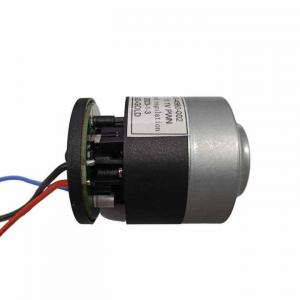

Add to Cart
Description:
BLDC motor has two types of structure: inner rotor motor and outer rotor motor. The advantages of the internal rotor motor are that the rotor has low moment of inertia and very fast heat dissipation, which is widely used in most industrial applications. The stator of the outer rotor motor is located on the inside, and the rotor includes a rotating housing on which the magnet is mounted. The stator heating coil is isolated from the environment and the heat dissipation is relatively slow. Because the moment of inertia of the rotor is very large and it is difficult to control the balance of the rotor housing, the external rotor motor is not suitable for the mode of high rotation speed. But the outer rotor motor can have a shorter construction and generally have a smaller stopping and turning moment, and because it has a larger rotor diameter under the same magnetic force, its torque is also larger.
Depending upon the control power supply capability, the motor with the correct voltage rating of the stator can be chosen. Forty-eight volts, or less voltage rated motors are used in automotive, robotics, small arm movements and so on. Motors with 100 volts, or higher ratings, are used in appliances, automation and in industrial applications.
Basic Parameters:
Outline Drawing:
The rotor is made of permanent magnet and can vary from two to eight pole pairs with alternate North (N) and South (S) poles.
Based on the required magnetic field density in the rotor, the proper magnetic material is chosen to make the rotor. Ferrite magnets are traditionally used to make permanent magnets. As the technology advances, rare earth alloy magnets are gaining popularity. The ferrite magnets are less expensive but they have the disadvantage of low flux density for a given volume. In contrast, the alloy material has high magnetic density per volume and enables the rotor to compress further for the same torque. Also, these alloy magnets improve the size-to-weight ratio and give higher torque for the same size motor using ferrite magnets.
Neodymium (Nd), Samarium Cobalt (SmCo) and the alloy of Neodymium, Ferrite and Boron (NdFeB) are some examples of rare earth alloy magnets. Continuous research is going on to improve the flux density to compress the rotor further.
Unlike a brushed DC motor, the commutation of a BLDC motor is controlled electronically. To rotate the BLDC motor, the stator windings should be energized in a sequence. It is important to know the rotor position in order to understand which winding will be energized following the energizing sequence. Rotor position is sensed using Hall effect sensors embedded into the stator.
Most BLDC motors have three Hall sensors embedded into the stator on the non-driving end of the motor.
Whenever the rotor magnetic poles pass near the Hall sensors, they give a high or low signal, indicating the N or S pole is passing near the sensors. Based on the combination of these three Hall sensor signals, the exact sequence of commutation can be determined.
